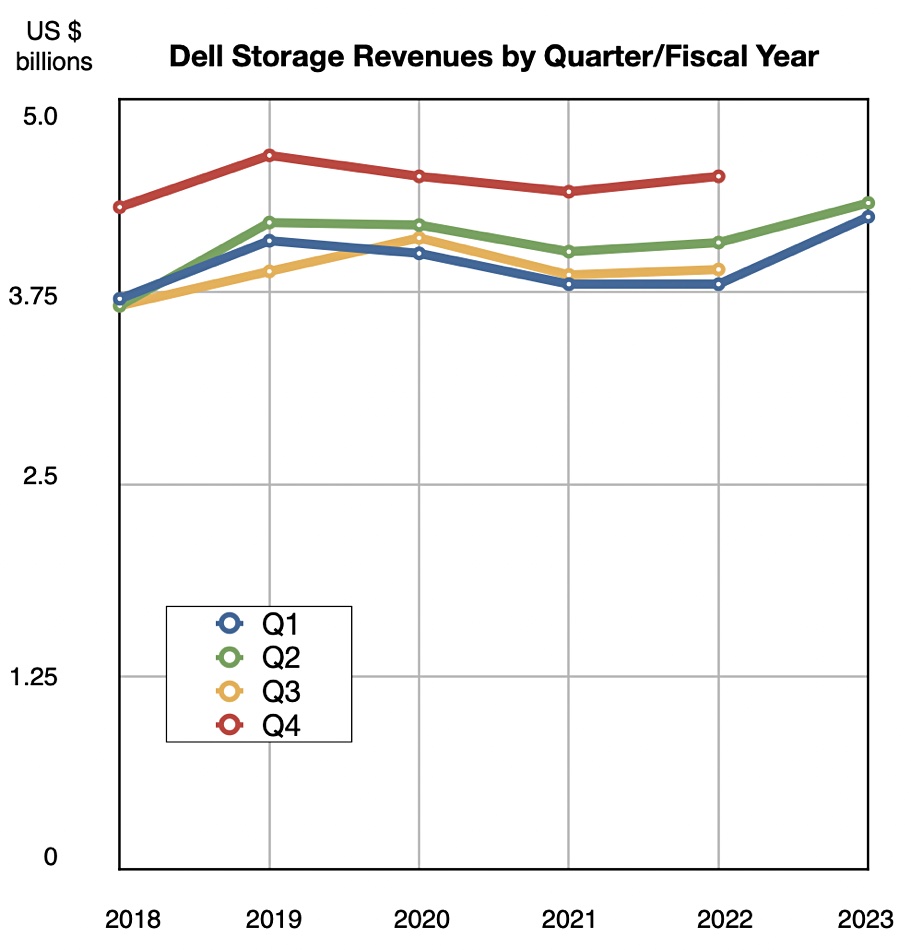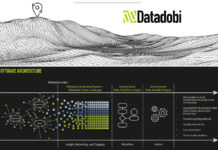Dell Technologies experienced growth in its second fiscal quarter but demand signals suggest a revenue decline next quarter.
The company reported record $26.4 billion revenues for its second fiscal 2023 quarter, up 9.2 percent on the year, with a 6.3 percent increase in storage revenues as demand strengthened for high-end storage and the mid-range PowerStore product.
Chuck Whitten, Dell co-COO, said: “We delivered strong CSG and ISG growth and profitability – with revenue up 12 percent and 9 percent respectively – although we observed more cautious customer behavior as the quarter progressed. Customers continue to prioritize advanced technology solutions to compete and succeed in the years ahead, and we are confident in our long-term opportunities.”
Client Solutions Group (CSG) revenues in the quarter ended July 29 were $15.49 billion, up 8.6 percent on the year, with Infrastructure Solutions Group (ISG) revenues of $9.54 billion; 11.5 percent more than last year. ISG’s servers and networking component was the star, contributing $5.21 billion, 16.3 percent more than a year ago, with storage pulling in $4.33 billion; it was $4.07 billion a year ago, and Dell has now had five consecutive storage growth quarters. Dell made a profit of $506 million, which was 43 percent lower than the year-ago $880 million.

The APEX public cloud-like subscription model for ISG products grew its Annual Recurring Revenue (ARR) to $1 billion-plus with almost 200 new customers and a 78 percent year-on-year growth in APEX orders.
Financial summary
- Gross margin: 20.6 percent; it was 26.6 percent a year ago
- Cash & cash equivalents: $7.1 billion
- Coe debt balance: $16.1 billion
- Cash flow from operation: $700 million
- Free cash flow: -$83 million compared to -$959 million in the prior quarter and $1.1 billion a year ago
Co-COO Jeff Clarke said Dell gained PC share in calendar Q2, and expects to gain share in server and storage when IDC releases its Q2 results in September.
But demand slowed in the quarter as consumers and business, particularly large businesses, responded to negative economic events. He said: “We have responded swiftly by managing inventories down and reducing our expenditures.”
Dell is “still seeing shortage of parts with embedded integrated circuits, including power supplies and NICs.”
This means that the “ISG backlog, particularly servers, remains elevated.” However, “PC backlog is now at normal levels as Q2 PC shipments significantly outpaced demand, and the portfolio is on standard lead time across the board.”
Whitten said: “There has been a clear and significant increase in the size of the PC market from pre-pandemic levels as hybrid work has become the default approach for companies worldwide.”
He went on to provide more storage demand details: “In Q2, we saw modest storage demand growth with strength in the high end and in our marquee mid-range product PowerStore, which grew double digits and has grown every single quarter since launch.”
Clarke added that: “PowerStore… is nearly half of our midrange mix now, 24 percent of the customers are new.”
Clarke said in the earnings call: “We think storage is an opportunity for us to continue to drive higher revenue. We have the broadest portfolio in the marketplace. We cover every aspect of the storage market from a high end to the mid-range, to the entry level, to the unstructured space, to the data protection space, all highly valuable categories in storage, which allows us to drive differentiated revenue in our storage business.”
Dell’s response to the slowdown in demand growth is to cut operating expenses; limiting external hiring and pulling back discretionary spending for example. It will be careful raising pricing as it doesn’t see a lot of elasticity in customers, particularly in the consumer area. Lift prices too much and they’ll simply stop buying. In servers and storage the environment is more forgiving because of backlogs and demand being ahead of supply. Clarke said this “enables us to pass along our increased costs.”
Outlook sees decline but not for storage
The outlook for the next quarter is a $23.8 billion to $25 billion revenue range. This would be an 8 percent year-on-year decline at the mid-point. Dell sees CSG declining in the high teens but ISG growing in the low teens. It now expects revenue growth for the whole of fiscal 2023 to be 0-2 percent, down from the previous 6 per cent growth expectation.
Sweet talked about “ISG growing sort of in that high-single digits, low-double digits through the back half of the year.” He said: “We are a bit more optimistic about storage demand than we are about server demand at this point… we do expect storage demand growth again in Q3.”
For example, the mainframe refresh cycle should pull more high-end PowerMax sales in its wake.
Yesterday we reported NetApp’s fiscal 2023 forecast of 6-8 percent revenue growth over 2022; quite a difference from Dell’s overall 8 percent decline. With Dell’s ISG storage growth forecast being in the mid single digits, Dell and NetApp are singing off the same hymn sheet.
Bootnote
Dell has revised the last fiscal year’s Q2 numbers to exclude VMware and so provide a like-for-like comparison. Thus in August last year Dell’s Q2 2022 results had a $26.1 billion revenue number. Now we are told that Dell’s Q2 2022 revenues were $24.191 billion; a $1.909 billion revision downwards.








